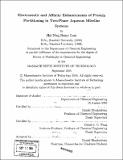| dc.contributor.advisor | Daniel Blankschtein and Daniel I.C. Wang. | en_US |
| dc.contributor.author | Lam, Hei Ning Henry | en_US |
| dc.contributor.other | Massachusetts Institute of Technology. Dept. of Chemical Engineering. | en_US |
| dc.date.accessioned | 2006-07-31T15:25:12Z | |
| dc.date.available | 2006-07-31T15:25:12Z | |
| dc.date.copyright | 2005 | en_US |
| dc.date.issued | 2005 | en_US |
| dc.identifier.uri | http://hdl.handle.net/1721.1/33700 | |
| dc.description | Thesis (Ph. D.)--Massachusetts Institute of Technology, Dept. of Chemical Engineering, 2005. | en_US |
| dc.description | Includes bibliographical references (p. 175-188). | en_US |
| dc.description.abstract | This thesis was motivated by the practical need to develop a scalable and cost-effective separation method for low-cost, high-volume protein products. This unmet challenge can potentially be addressed by extraction in two-phase aqueous micellar systems, in which biomolecules can be partitioned in mild, predominantly aqueous environments. The goal of this thesis was to explore various ways of enhancing protein partitioning in two-phase aqueous micellar systems, by the incorporation of electrostatic and affinity interactions, to obtain satisfactory yield and specificity for the purification of industrially relevant hydrophilic proteins. The electrostatically-enhanced partitioning of the enzyme glucose-6-phosphate dehydrogenase (G6PD) in two-phase aqueous mixed (nonionic/cationic) micellar systems was investigated experimentally and theoretically. The successful enhancement, up to 22-fold, of the partitioning of the negatively-charged G6PD was attained by adding the positively- charged surfactant alkyltrimethylammonium bromide (CnTAB) to form charged mixed micelles with the phase-forming nonionic surfactant, decyl tetra(ethylene oxide) (C₁₀E₄). | en_US |
| dc.description.abstract | (cont.) The effects of the tail length of the positively-charged surfactant on protein denaturation and protein partitioning behavior were also studied. Furthermore, the experimental results were used to validate a predictive theory for electrostatic enhancement. In the area of affinity enhancement, the affinity-enhanced partitioning of an engineered affinity-tagged protein, CBM9-GFP (Green Fluorescent Protein linked to a carbohydrate- binding module), in two-phase aqueous micellar systems was investigated experimentally and theoretically. The experimental results showed that the partition coefficient of the target protein, CBM9-GFP, can be improved more than 6-fold, by virtue of the affinity interactions, and that the enhancement is specific to the target protein. The system utilized requires only one surfactant, decyl [beta]-D-glucopyranoside (C₁₀G₁), which acts simultaneously as the affinity ligand and as the phase-forming surfactant, and as such, has important practical advantages. A novel theoretical framework to describe affinity- enhanced protein partitioning in two-phase aqueous micellar systems was developed and validated experimentally. In addition, the separation method developed was successfully applied to a real cell lysate. | en_US |
| dc.description.abstract | (cont.) It was found that the protein impurities in the cell lysate do not interfere with the partitioning of the target protein (CBM9-GFP) at industrially relevant concentrations, and that the protein impurities were concentrated away from the target protein. Lastly, the theoretical description developed was used to identify various strategies for improving the affinity-enhanced partitioning of the target protein in two-phase aqueous micellar systems. Although more work remains to be done before the separation methods studied in this thesis can reach their full potential and be eventually commercialized, this thesis nevertheless represents an essential starting point for future efforts to improve, extend, and commercialize this promising bioseparation method. | en_US |
| dc.description.statementofresponsibility | by Hei Ning Henry Lam. | en_US |
| dc.format.extent | 188 p. | en_US |
| dc.format.extent | 10264055 bytes | |
| dc.format.extent | 10271948 bytes | |
| dc.format.mimetype | application/pdf | |
| dc.format.mimetype | application/pdf | |
| dc.language.iso | eng | en_US |
| dc.publisher | Massachusetts Institute of Technology | en_US |
| dc.rights | M.I.T. theses are protected by copyright. They may be viewed from this source for any purpose, but reproduction or distribution in any format is prohibited without written permission. See provided URL for inquiries about permission. | en_US |
| dc.rights.uri | http://dspace.mit.edu/handle/1721.1/7582 | |
| dc.subject | Chemical Engineering. | en_US |
| dc.title | Electrostatic and affinity enhancements of protein partitioning in two-phase aqueous micellar systems | en_US |
| dc.type | Thesis | en_US |
| dc.description.degree | Ph.D. | en_US |
| dc.contributor.department | Massachusetts Institute of Technology. Department of Chemical Engineering | |
| dc.identifier.oclc | 64664477 | en_US |
